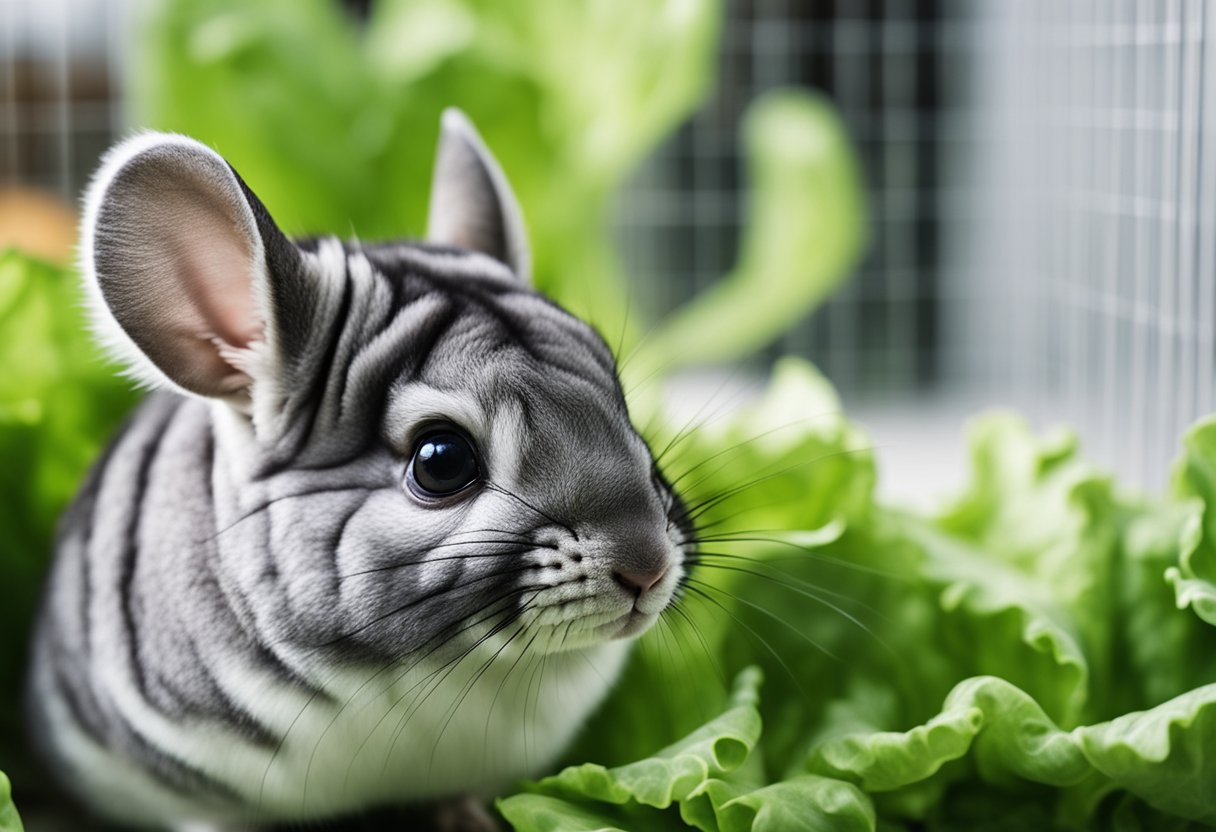If you own a chinchilla, you may wonder about the safety of certain foods, including romaine lettuce. Chinchillas can eat romaine lettuce, but it should be offered in very small amounts. While it is not toxic, lettuce lacks essential nutrients and should not be a staple in their diet. Understanding what your pet can and cannot eat is crucial for their health and happiness.

Incorporating leafy greens can seem appealing, especially when thinking about variety in your chinchilla’s diet. It’s important to choose safer options and to introduce new foods gradually. Learning about the right foods can help you provide the best care for your furry friend.
Key Takeaways
- Chinchillas can have small amounts of romaine lettuce.
- Leafy greens should not be a main part of their diet.
- Always introduce new foods slowly to avoid digestive issues.
Dietary Needs of Chinchillas

Chinchillas have specific dietary requirements crucial for their health. Understanding these needs will help you keep your pet in optimal condition. It’s essential to know what to feed them and what to avoid, such as romaine lettuce.
Nutritional Requirements
Chinchillas need a diet high in fiber and low in moisture. The primary component of their diet should be hay, particularly timothy hay. It provides the necessary roughage to maintain digestive health.
You can also offer specialized pellets formulated for chinchillas. These pellets should be given in small amounts, about 30 to 80 grams per day.
Occasional treats, like a small piece of fruit or vegetable, can be included once a week. Always prioritize high-fiber options to support their digestion.
A balanced diet helps prevent obesity and digestive issues. Always avoid any food high in sugar or fat. Be mindful to research any new food before introducing it.
Risks of Feeding Romaine Lettuce
Feeding romaine lettuce to chinchillas carries several risks. While lettuce is not toxic, it has a very high water content of over 95%. This can lead to digestive upset, including diarrhea.
Chinchillas thrive on high-fiber foods, and romaine lettuce offers only about 1.3% fiber. This is not enough to meet their dietary needs and could upset their stomachs.
Instead of lettuce, opt for hay or safe vegetables that provide better nutrition. If you want to offer greens, do so sparingly and choose ones with higher fiber content.
Monitoring your chinchilla’s health is crucial. If you notice changes in behavior or digestion after introducing new foods, consult a veterinarian promptly.
Feeding Chinchillas Leafy Greens

Leafy greens can offer some variety in your chinchilla’s diet. However, it is important to know which greens are safe and how to introduce them.
Safe Leafy Greens for Chinchillas
When considering leafy greens for your chinchilla, not all options are safe. Here are some greens that you can feed your pet:
- Kale: High in vitamins and can be given in small amounts.
- Spinach: Provides vitamins but should only be offered occasionally due to its high water content.
- Collard Greens: Another nutritious choice, but feed in moderation.
- Basil: An aromatic herb that adds flavor without excess water.
Avoid these greens: Lettuce, especially iceberg, is not suitable due to its high water content which can lead to digestive issues. Always wash greens thoroughly and serve in small portions to prevent overeating.
Introducing New Foods
Introducing new foods to your chinchilla’s diet requires caution. Start with small amounts to monitor how your pet reacts.
- Choose One Green: Pick one safe leafy green to begin with.
- Watch for Reactions: After feeding, observe your chinchilla for any signs of discomfort or changes in behavior.
- Gradual Increase: If well-tolerated, gradually increase the quantity over a week or so.
This method helps your chinchilla adjust without overloading its system. Remember, the main part of their diet should still be hay and pellets. Keep a close eye to ensure that leafy greens enhance their diet without causing any health problems.
Resources

If you’re considering adding romaine lettuce to your chinchilla’s diet, it’s good to know the facts.
- Nutritional Value
Romaine lettuce has high water content and low nutritional value. While it won’t harm your chinchilla, it should not be a staple in their diet. - Safe Serving Size
Limit lettuce treats to a small amount, such as 1-2 tablespoons a few times a week. This helps prevent digestive issues. - Other Safe Vegetables
Consider other vegetables like:- Carrots: Nutrient-rich and good for your pet.
- Bell Peppers: Great for vitamins and fiber.
- Kale: A leafy green that adds variety.
For more detailed guidance on feeding your chinchilla, you can visit Chef’s Resource on vegetables for chinchillas. They provide a list of safe options and serving suggestions.
Also, learn about the pros and cons of giving your chinchilla lettuce at Planet Chinchilla.
Make sure to keep your chinchilla’s diet balanced with timothy hay and limited pellets, while offering a mix of veggies. This ensures they stay healthy and happy. For tips on maintaining your pet’s health, check out Berry Patch Farms on chinchilla diets.
Frequently Asked Questions

When it comes to feeding your chinchilla, it’s important to know which vegetables are safe and how often to give them. This section covers specific questions about lettuce and other vegetables in your chinchilla’s diet.
What types of lettuce, if any, are safe for chinchillas to eat?
Romaine lettuce is one type of lettuce that can be given to chinchillas in small amounts. It is better than iceberg lettuce, which has very low nutritional value. Always choose fresh, green romaine and avoid any wilted or spoiled pieces.
How often can chinchillas safely consume romaine lettuce?
You can offer romaine lettuce to your chinchilla occasionally, about once a week. Limit the amount to a small portion to avoid digestive issues. Too much leafy green can lead to diarrhea and other health problems.
Are there any vegetables that are harmful to chinchillas?
Certain vegetables can be harmful to chinchillas. Avoid giving them starchy vegetables like potatoes or corn, as well as onions and garlic. These can upset their sensitive digestive systems or cause serious health issues.
What is the best way to include vegetables in a chinchilla’s diet?
Introduce vegetables slowly and in small amounts. Start with one type of vegetable at a time to see how your chinchilla reacts. Fresh hay should remain the main part of their diet, with vegetables as occasional treats.
Can chinchillas have raw vegetables, and if so, which ones?
Yes, chinchillas can eat raw vegetables, but choices are limited. Safe options include small amounts of dark leafy greens like kale or spinach. Always ensure these vegetables are fresh and washed properly before offering them.
What should be considered when feeding carrots to chinchillas?
Carrots should be given sparingly since they are high in sugar. You can offer a small piece occasionally, but avoid making them a regular part of the diet. Monitor your chinchilla’s health after introducing any new foods, including carrots.

